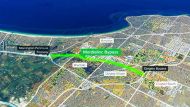The Andrews government is preparing to unveil $8.3 billion worth of budget surpluses over the next four years, providing a hefty buffer to unleash new spending as next year's election looms.
Tuesday's state budget will confirm Victoria remains flush with cash, with strong revenues from property, business activity and rising employment flowing into Treasury's coffers.
More Victoria News Videos
Premier Andrews announces $81m for ice rehab
An Andrews government plan to tackle the ice crisis was revealed on Friday, ahead of the state budget. Vision courtesy Seven News Melbourne.
Spending is expected to continue rising solidly, underpinned by a soaring public sector wage bill and other costs linked to booming population growth.
But that will still be slightly less than the growth in revenues, allowing the government to predict a $1.2 billion surplus for the coming financial year, rising to an annual average of $2.4 billion for the remaining three years of the budget period.

Treasurer Tim Pallas said the purpose of maintaining surpluses was to provide the headroom to "inoculate" the state economy against economic shocks and to keep a lid on debt.
"I don't fixate about the number so much, other than it does give confidence to the markets [that] we are in the business of keeping our economic settings prudent and that the output expenditure is being managed well," he said.
But the windfall gain will also provide Labor - and the state opposition - with room to make big spending announcements in the lead up to the November 2018 election.
Mr Pallas has previously flagged a plan to lift debt levels back towards those the government inherited of 6.2 per cent of the state economy to take advantage of record-low borrowing costs to build infrastructure to cope with population growth.
The budget will predict net debt equivalent to 5.8 per cent of the state economy next financial year, rising to 6 per cent within the next three years. But that, along with the healthy budget position, will allow the government to ramp up infrastructure spending.
The budget will predict the government will spend an average of $9.6 billion a year on infrastructure over the next four years. That would be almost double the annual average spend of about $5 billion a year over the decade to 2016.
Victoria has long complained it has been severely short-changed by the Commonwealth on infrastructure funding.
Treasury figures provided to Fairfax Media show that if Victoria received a share of Commonwealth infrastructure funding commensurate with the state's share of the national population, it would be about $6.6 billion better off over five years.
In the wake of the windfall $9.7 billion Port of Melbourne lease deal, the government is also preparing to announce a further asset sale. There is also likely to be further public sector "efficiency" savings to help fund the recommendations of the Royal Commission into Family Violence.
The budget will also predict annual economic growth of 2.75 per cent over the next four years, with unemployment tipped to fall from 5.9 per cent last financial year to about 5.5 per cent.
Many big ticket items in the coming budget have already been announced, including $2 billion for more police and other safety initiatives, $846 million brought forward to remove eight additional level crossings before 2018 and about $271 million for redevelopment works at Melbourne Park.
The budget will also include $308 million to overhaul management of serious offenders, including a new high-security detention facility for violent criminals after they complete their sentences.
About $81 million will go to the Ice Action Plan with some of that funding going to more rehabilitation beds.














